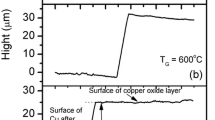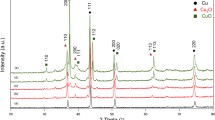Abstract
Long (15 - 40 μm), thin (diameter of 20 ± 5 nm), and well-dispersed CuNWs Cu nanowires were prepared. The high-resolution TEM and selected area electron diffraction showed that the CuNWs were single-crystalline. To investigate the growth mechanism, we examined the microstructure of these CuNWs at different reaction time. It was found that the CuNWs were actually formed through the self-assembling of Cu nanoparticles along the [110] direction. The transparent electrodes fabricated using the CuNWs achieved a high transparency of 76 % at 31±5 Ω/□.
Similar content being viewed by others
References
Lee J Y, Connor S T, Cui Y, et al. Semitransparent Organic Photovoltaic Cells with Laminated Top Electrode[J]. Nano lett., 2010, 10(4): 1 276–1 279
Gomez De Arco L, Zhang Y, Schlenker C W, et al. Continuous, Highly Flexible and Transparent Graphene Films by Chemical Vapor Deposition for Organic Photovoltaics[J]. ACS Nano, 2010, 4(5): 2 865–2 873
Borchert J W, Stewart I E, Ye S, et al. Effects of Length Dispersity and Film Fabrication on the Sheet Resistance of Copper Nanowire Transparent Conductors[J]. Nanoscale, 2015, 7(34): 14 496–14 504
Leterrier Y, Medico L, Demarco F, et al. Mechanical Integrity of Transparent Conductive Oxide Films for Flexible Polymer–Based Display[J]. Thin Solid Films, 2004, 460(1–2): 156–166
Ravi Kumar D V, Woo K, Moon J. Promising Wet Chemical Strategies to Synthesize Cu Nanowires for Emerging Electronic Applications[J]. Nanoscale, 2015, 7(41): 17 195–17 210
Wang R R, Sun J, Gao L A, et al. Base and Acid Treatment of SWCNT–RNA Transparent Conductive Films [J]. ACS Nano, 2010, 4(8): 4 890–4 896
Wang R R, Sun J, Gao L A, et al. Effective Post Treatment for Preparing Highly Conductive Carbon Nanotube Reduced Graphite Oxide Hybrid Films[J]. Nanoscale, 2011, 3(3): 904–906
Hu L, Kim H S, Lee J Y, et al. Scalable Coating and Properties of Transparent, Flexible, Silver Nanowire Electrodes[J]. ACS Nano, 2010, 4(5): 2 955–2 963
Van de Lagemaat J, Barnes T M, Rumbles G, et al. Organic Solar Cells with Carbon Nanotubes Replacing Zn2O3: Sn as the Transparent Electrode[J]. App. Phys. Lett., 2006, 88(23): 233 503
Kim U J, Lee I H, Bae J J, et al. Graphene/Carbon Nanotube Hybrid–Based Transparent 2D Optical Array[J]. Adv. Mater. 2011, 23(33): 3 809–3 814
De S, Higgins T M, Lyons P E, et al. Silver Nanowire Network as Flexible, Transparent, Conducting Films: Extremely High DC to Optical Conductivity Ratios[J]. ACS Nano, 2009, 3(7): 1 767–1 774
Zhang D Q, Wang R R, Wen M C, et al. Synthesis of Ultralong Copper Nanowires for High–Performance Transparent Electrode[ J]. J. Am. Chem. Soc., 2012, 134(35): 1 4283–14 286
Rathmell A R, Wiley B J. The Synthesis and Coating of Long, Thin Copper Nanowires to Make Flexible, Transparent Conducting Films on Plastic Substrates[J]. Adv. Chem. Soc., 2011, 23(41): 4 798–4 803
Ye S, Stewart I E, Chen Z F, et al. How Copper Nanowires Grow and How To Control Their Properties[J]. Acc. Chem. Res., 2016, 49(3): 442–451
He C, Liu G, Zhang W X, et al. Tuning the Structure and Electron Transport Properties of Ultra Thin Cu Nanowire by Size and Bending Stress Using DFT and FTB Methods[J]. RSC. Adv., 2015, 5(29): 22 463–22 470
Rathmell A R, Bergin S M, Hua Y L, et al. The Growth Mechanism of Copper Nanowires and Their Properties in Flexible, Transparent Conducting Films[J]. Adv. Mater., 2010, 22(32): 3 558–3 563
Jin S M, He G N, Zhang H, et al. Shape–Controlled Synthesis of Copper Nanocrystals in an Aqueous Solution with Glucose as a Reducing Agent and Hexadecylamine as a Capping Agent[J]. Angew. Chem. Int. Ed., 2011, 50(45): 10 560–10 564
Yang H J, He S Y, Tuan H Y. Self–Seeded Growth of Five–Fold Twinned Copper Nanowires: Mechanistic Study, Characterization, and SERS Applications[J]. Langmuir, 2014, 30(2): 602–610
Guo H Z, Lin N, Chen Y Z, et al. Copper Nanowires as Fully Transparent Conductive Electrodes. [J]. Sci. Rep., 2013, 3: 2 323
Meng F, Jin S. The Solution Growth of Copper Nanowires and Nanotubes is Driven by Screw Dislocations[J]. Nano. Lett., 2012, 12(1): 234–239
Ye S, Rathmell A R, Stewart I E, et al. A Rapid Synthesis of High Aspect Ratio Copper Nanowires for High–Performance Transparent Conducting Films[J]. Chem.Commun., 2014, 50(20): 2 562–2 564
Xia Y N, Xiong Y J, Lim B, et al. Shape–Controlled Synthesis of Metal Nanocrystals: Simple Chemistry Meets Complex Physics[ J]? Angew. Chem. Int. Ed., 2009, 48(1): 60–103
Nam V B, Lee D. Copper Nanowires and Their Applications for Flexible, Transparent Conducting Films: A Review[J]. Nanomater., 2016, 6(3): 47
Nandwana V, Elkins K E, Poudyal N, et al. Size and Shape Control of Monodisperse FePt Nanoparticles[J]. J. Phys. Chem. C, 2007, 111(11): 4 185–4 189
Author information
Authors and Affiliations
Corresponding author
Additional information
Funded by “Hundreds of Talents Program” of Hubei Province, China
Rights and permissions
About this article
Cite this article
Wu, J., Guo, L., Wen, M. et al. The Self-Assembling Growth of Copper Nanowires for Transparent Electrodes. J. Wuhan Univ. Technol.-Mat. Sci. Edit. 34, 145–149 (2019). https://doi.org/10.1007/s11595-019-2028-8
Received:
Accepted:
Published:
Issue Date:
DOI: https://doi.org/10.1007/s11595-019-2028-8




